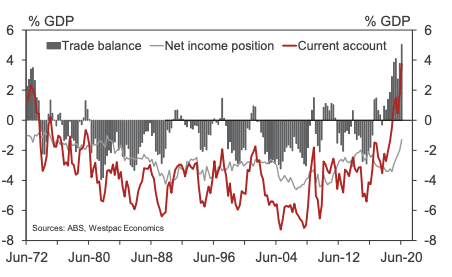Australian Dollar Pushes 5-Week High against the Pound, Underpinned by Record Current Account Data
- Current account surplus hits record high
- GBP/AUD breaking down
- AUD/USD at 25 month highs
- Strong chinese data aids AUD at start of new month

Image © Adobe Stock
- GBP/AUD rate at time of publication: 1.8200
- Bank transfer rates (indicative guide): 1.7563-1.7690
- FX specialist rates (indicative guide): 1.7776-1.8036
- More information on bank beating rates, here
The Pound-to-Australian Dollar exchange rate fell to 5-week lows at 1.8107 at the start of September before a broad-based recovery in Sterling saw some of the earlier losses ease, although the currency retains its recent advantage against the Euro and U.S. Dollar.
The Aussie Dollar was on September 01 aided by supportive domestic news as well as supportive data out of China. Asian and Australian markets went higher on September 01 after China's Caixin/IHS Markit manufacturing Purchasing Managers’ Index (PMI) came in at 53.1 for August, compared to 52.8 in July.
Economists polled by Reuters had expected Caixin/Markit manufacturing PMI to come in at 52.7. PMI readings above 50 indicate expansion, while those below that signal contraction, suggesting the recovery in Australia's largest and most important trading partner remains intact.
Total new work expanded at the sharpest rate since the start of 2011 amid reports of firmer client demand as the domestic and global economy continued to recover from the pandemic according to IHS Markit. Notably, manufacturers registered the first increase in new export sales since December 2019.
“Overall, the post-epidemic economic recovery in the manufacturing sector continued. Supply and demand expanded with the pickup in overseas demand. Backlogs of work continued to increase," says Wang Zhe, Senior Economist at Caixin Insight Group.
The Australian Dollar has been one of the better performing major currencies of the past month, aided by an ongoing rally in global stock markets and improved commodity prices which continue to boost Australia's foreign currency earnings.
"The broader backdrop of recovering commodity markets and shipping, as the world attempts to head back to normality, is supporting the commodity currencies, particularly AUD," says Robin Wilkin, Cross Asset Strategist at Lloyds Bank.
The supportive fundamental backdrop underpinning the Aussie Dollar was reaffirmed on September 01 when official statistics showed the country's trade surplus (where the value of exports exceed imports) climbed to a record high of 3.7% of GDP.
This is the highest reading since records began in 1959 and comes as the Australian Dollar reaches a new 25 month high against the U.S. Dollar, with the AUD/USD exchange rate quoted at 0.7405 on September 01.
Above: Australia's trade surplus hits a record. If you have outstanding AUD payments and would like to protect your budget by booking current rates now for use in the future, please learn more here.
The second quarter current account stood at +$17.7BN, driven by a plummet in imports owing to the covid-19 pandemic, while exports stood up relatively well, largely driven by China's ongoing thirst for Australian iron ore, coal and natural gas as well as elevated global gold prices.
However, even exports have not been immune to the global slowdown, exports fell by 6.7% in the June quarter, following a 4.4% decline in the March quarter, to be 10.6% lower over the year.
Nevertheless, the fall in exports were eclipsed by a fall in imports which declined 14.1%, leaving a solid surplus which provides a solid underpinning for the Australian Dollar which has risen 4% against the Pound and 5.5% against the U.S. Dollar in 2020.
"Imports have been smashed by the pandemic - with Australia's economy in a partial lock-down in the June quarter and the international border closure grounding overseas travel by Australian residents," says Andrew Hanlan, Senior Economist at Westpac.
The current account will likely provide a source of support for the Australian Dollar going forward as it suggests at a basic level that the country is earning more than it is spending on the international stage, which creates a fundamental demand for Australian Dollars on the foreign exchange market.
With commodity prices remaining elevated thanks to robust Chinese demand, this fundamental outlook will likely remain in place. However, expect imports to rebound as the Australian and global economies find their feet in the second half of 2020 suggesting the record surplus recorded in the second quarter will unlikely be repeated.





